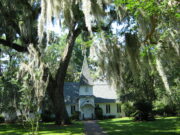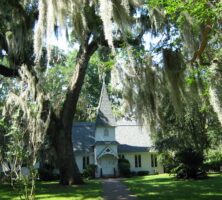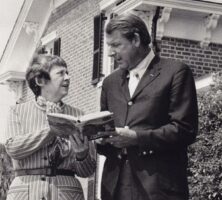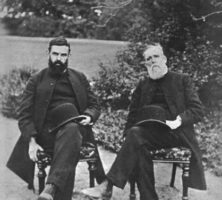Eugenia Price is known for her best-selling historical fiction, much of which is set in Georgia. At the time of her death in 1996, Price had written fourteen novels, twenty-two inspirational books, and three autobiographies. Her books have sold more than 40 million copies. Most of her novels appeared on the New York Times best-seller list, including her last novel, The Waiting Time, published after her death.
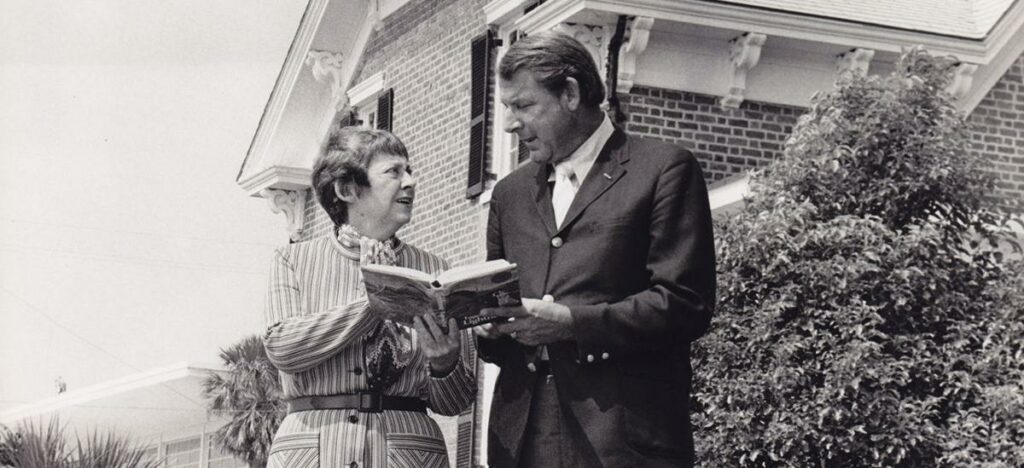
Courtesy of Coastal Georgia Historical Society.
Early Life and Career
Eugenia Price was born on June 22, 1916, in Charleston, West Virginia, to Anna Davidson and Walter Wesley Price, an upper-middle-class couple of German, Scottish, and Welsh ancestry. Price often credited her mother with nurturing her passions for writing, music, and history.
At the age of sixteen, Price left her Charleston home for Ohio University in Athens, Ohio. She began as an English major but changed to dentistry in her junior year and transferred to Northwestern University in Evanston, Illinois. Three years later, she transferred to the University of Chicago, where she listed philosophy as her major.
Price never earned a college degree, but when she was twenty-three years old, the National Broadcasting Company, better known as NBC, hired her to write for daytime serials. A few years later, she began working for Procter & Gamble in Cincinnati, Ohio, writing the serial Joyce Jordan, M.D. In 1945 she started her own company, Eugenia Price Productions, which produced daytime serials. She also broadcast daily radio commentary, and over the next few years she hosted or cohosted radio programs in Chicago.
By the late 1940s Price was well known in the radio broadcast business, having successfully tackled the roles of writer, director, producer, and host. Her popularity grew in the Midwest when she started cohosting Unshackled, a Christian radio show. Soon she was receiving invitations to speak at church and civic meetings, leading to her next career as an inspirational speaker and author. By 1962 Price had written eleven nonfiction books and traveled to nearly every state in the country, talking to standing-room-only audiences.
The St. Simons Trilogy
In late 1961, while en route from West Virginia to Florida for a book signing, Price visited St. Simons Island in Georgia for the first time. She had read about the island in a Southeastern American Automobile Association guidebook, which mentioned the story of a young minister, Anson Greene Phelps Dodge Jr., who in 1884 had rebuilt Christ Church in memory of his bride, Ellen, who died of cholera on their honeymoon in India. The church had been severely damaged by Union soldiers during the Civil War (1861-65).
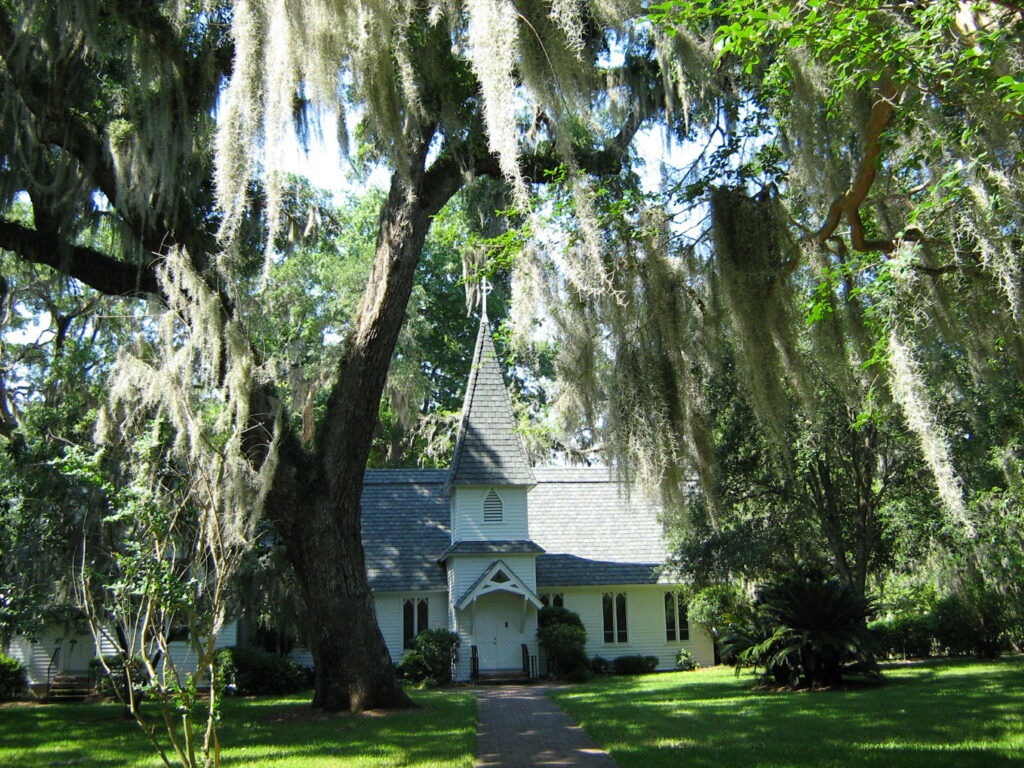
Image from septicbreath
For three years Price and her friend and fellow writer Joyce Blackburn researched the lives of Dodge, his first wife, and his second wife, Anna Gould Dodge. The writers spent hundreds of hours interviewing descendants of the Dodge and Gould families, as well as longtime St. Simons residents who remembered life on the island at the end of the nineteenth century. “Research for my earliest St. Simons stories came out of the brains of the oldest people I could find and out of people’s dresser drawers,” Price said in a 1982 newspaper interview.
The author used available resources—including eyewitness recordings, aging photographs, and the research of regional historians—and then maintained a chronology of key events during the period covered in her first novels, 1790s-1920s. What was to be one novel, The Beloved Invader, turned into three, and with the St. Simons trilogy—her first fiction—Price defined herself as a historical novelist who devoted months, sometimes years, to researching her subjects and the era in which they lived.
The St. Simons trilogy, written between 1962 and 1969, renewed interest in the history of the Golden Isles of Georgia—St. Simons, Jekyll, Sea Island, Cumberland, and Little St. Simons—and this interest resulted in the founding of the Coastal Georgia Historical Society, based in St. Simons, in 1965.
Community Activism
In 1965 Price and Blackburn moved from Chicago to St. Simons, where both continued to write. During her thirty-one years on the island, Price demonstrated a steadfast commitment to the community. She fought to ensure that the island’s marshes, beaches, indigenous flora, and wildlife would not be harmed by advancing industry and a growing coastal population; she supported, both vocally and financially, its historic sites, including the Lighthouse Museum and the Fort Frederica National Monument, as well as the Coastal Georgia Historical Society and the Georgia Sea Island Festival.
Price and Blackburn, an award-winning biographer and author of children’s books, established the Eugenia Price–Joyce Blackburn Foundation, a nonprofit organization whose proceeds fund grants and scholarships, support charitable organizations, and create programs that promote excellence in writing.
Price, who often traveled across the country to do promotional tours for her novels, always told her audiences about the two conversions that changed her life: one to Jesus Christ in October 1949 and the other to the American South in November 1961. The second conversion, she said, led to her three-decade career as a writer of historical fiction, which began with the St. Simons trilogy. Through her novels and her community activism, Price helped preserve the history of coastal Georgia. In 1988 this work was recognized when she received a Governor’s Award in the Humanities. Price died of congestive heart failure on May 28, 1996.
Price’s fiction includes The Beloved Invader (1965), New Moon Rising (1969), and The Lighthouse (1971), which make up the St. Simons trilogy; Don Juan McQueen (1974), Maria (1977), and Margaret’s Story (1980), the Florida trilogy; Savannah (1983), To See Your Face Again (1985), Before the Darkness Falls (1987), and Stranger in Savannah (1989), the Savannah quartet; Bright Captivity (1991), Where Shadows Go (1993), and Beauty from Ashes (1995), the Georgia trilogy; and The Waiting Time, published in 1997.
Although her early books focused on real people who lived in coastal Georgia during the eighteenth and nineteenth centuries—James Gould, Horace Gould, John Couper, Mary Gould, Anna Gould Dodge, and Anson Greene Phelps Dodge Jr.—her later novels featured fictional characters. It is the earlier novels that bring tourists to St. Simons year after year, where they walk among the moss-draped oaks in Christ Church Cemetery, searching for the graves of the islanders brought back to life in Price’s books.
In 2001 the Georgia Center for the Book, which promotes and celebrates Georgia literature, composed a list of twenty-five books every Georgian should read. Price’s The Lighthouse, the final installment in the St. Simons trilogy, was among the books. She was inducted into the Georgia Writers Hall of Fame in 2017.


